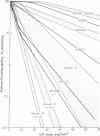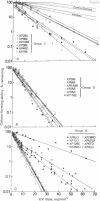Abstract
Xeroderma pigmentosum is an autosomal recessive disease in which DNA repair processes are defective. All xeroderma pigmentosum patients develop premature aging of sun-exposed skin, and some develop neurological abnormalities due to premature death of nerve cells. Sensitivity to ultraviolet radiation of 24 xeroderma pigmentosum fibroblast strains was studied in vitro by measuring each strain's ability to divide and form colonies after irradiation. The most sensitive strains were derived from patients who had an early onset of neurological abnormalities; less sensitive strains were from patients with a later onset; and the most resistant strains were from patients without neurological abnormalities. The UV sensitivities of strains from each member of a sibling pair with xeroderma pigmentosum were identical, indicating that UV sensitivity of xeroderma pigmentosum strains is determined by the patient's inherited DNA repair defect. The results suggest that effective DNA repair is required to maintain the functional integrity of the human nervous system by preventing premature death of neurons.
Full text
PDF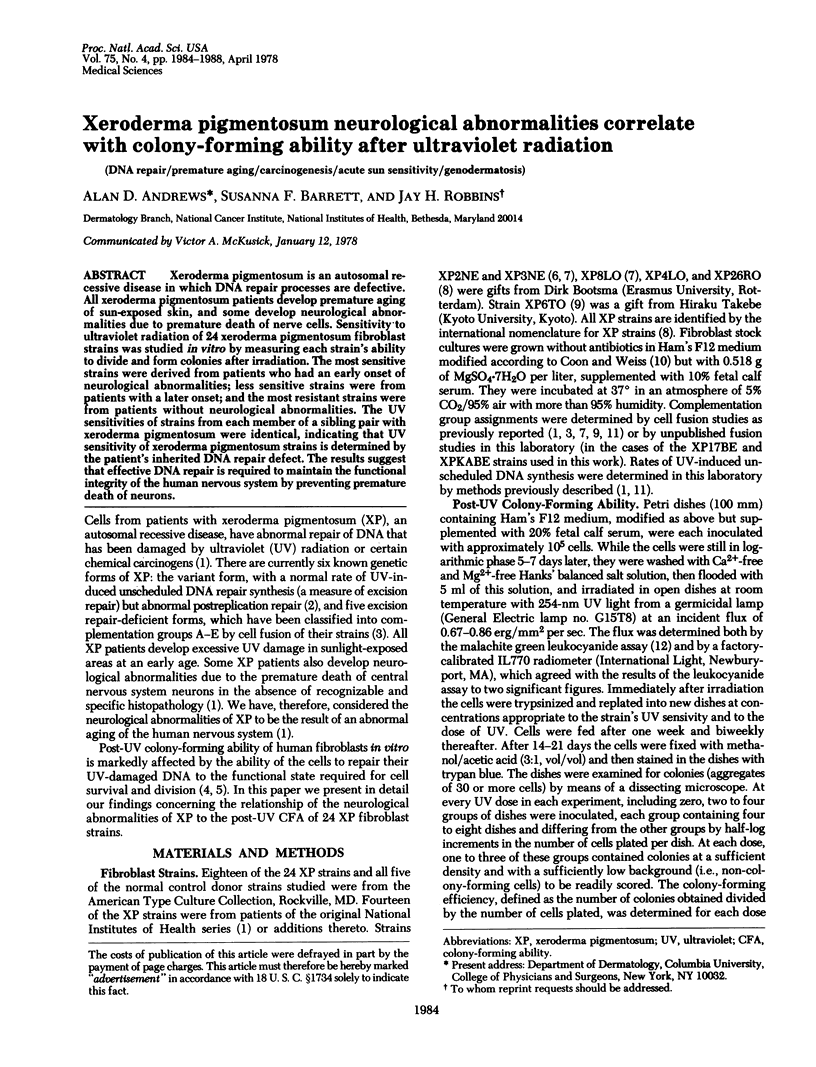
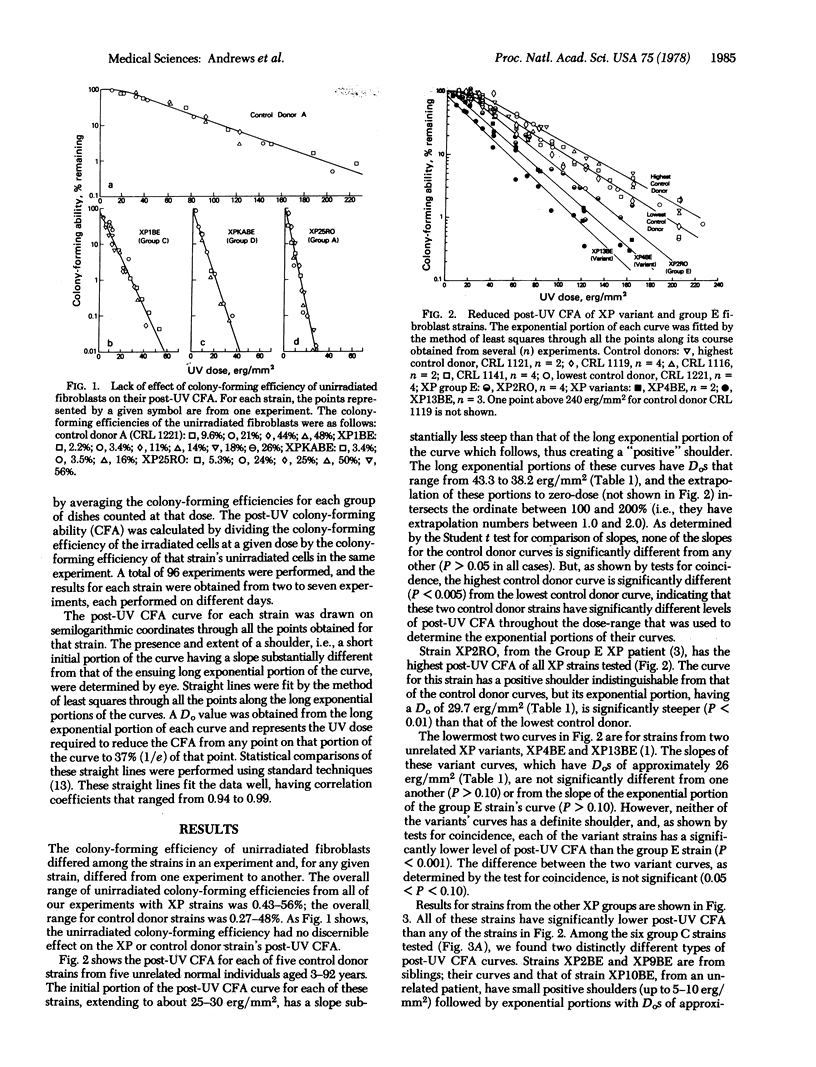
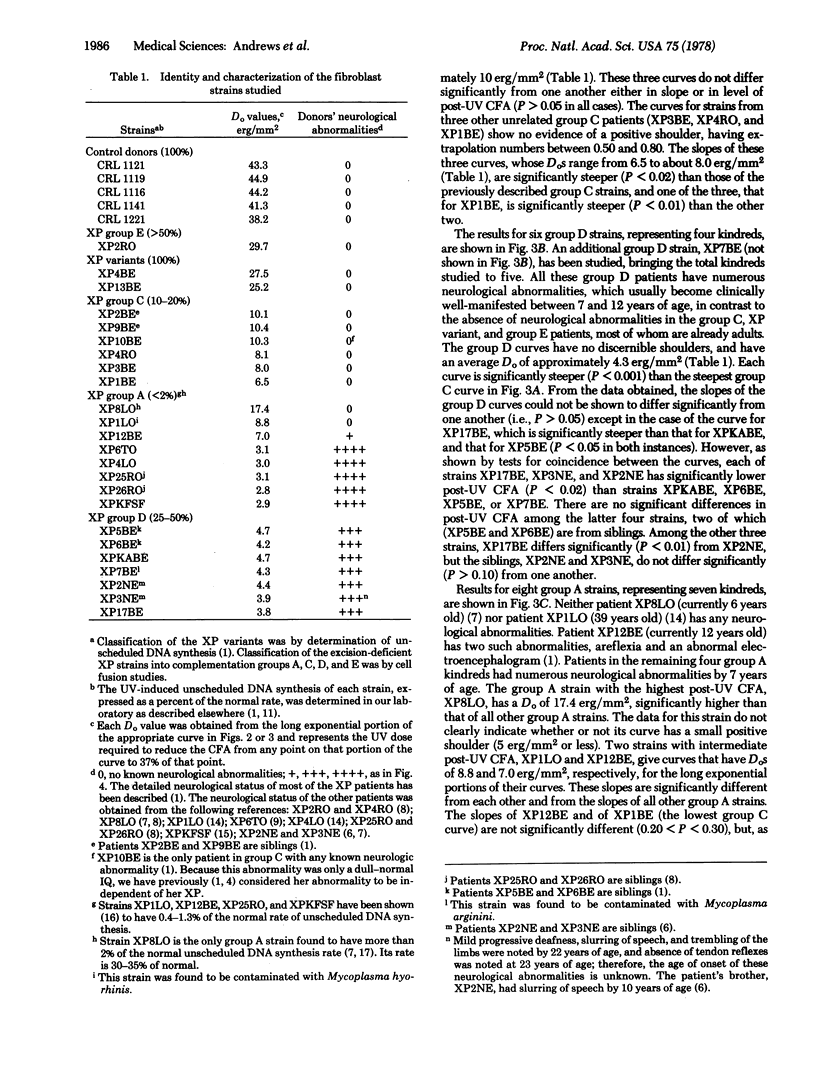
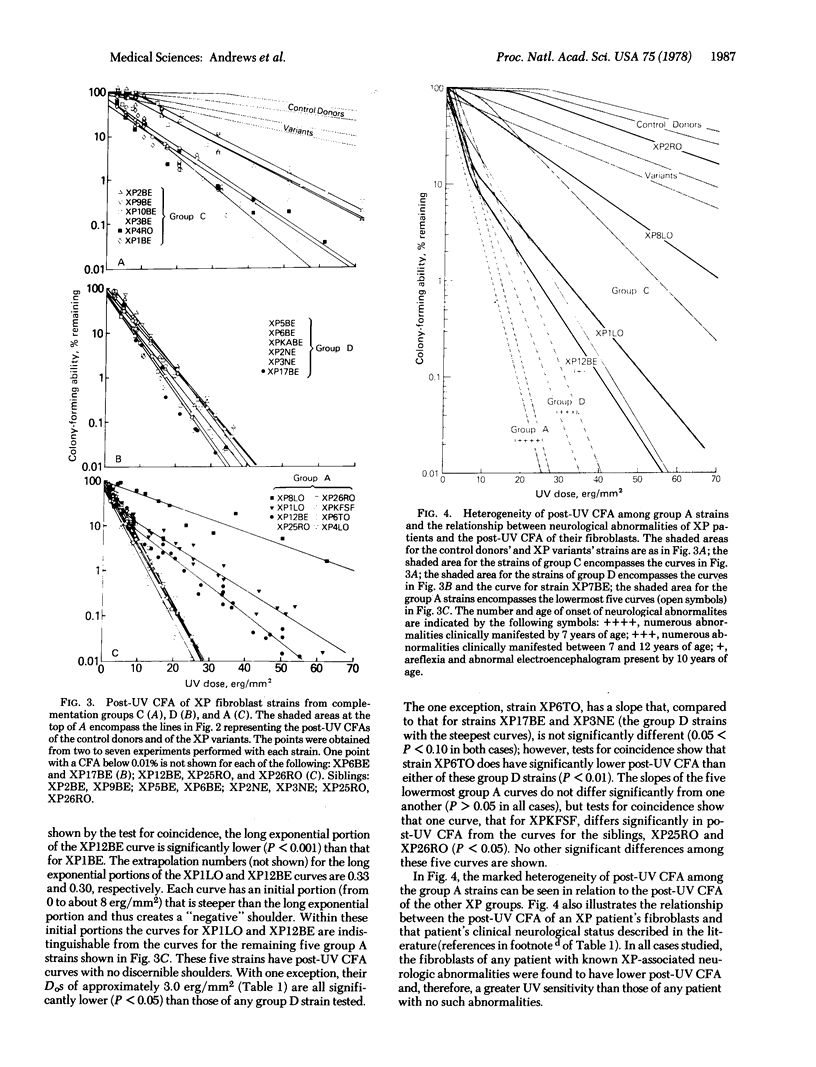
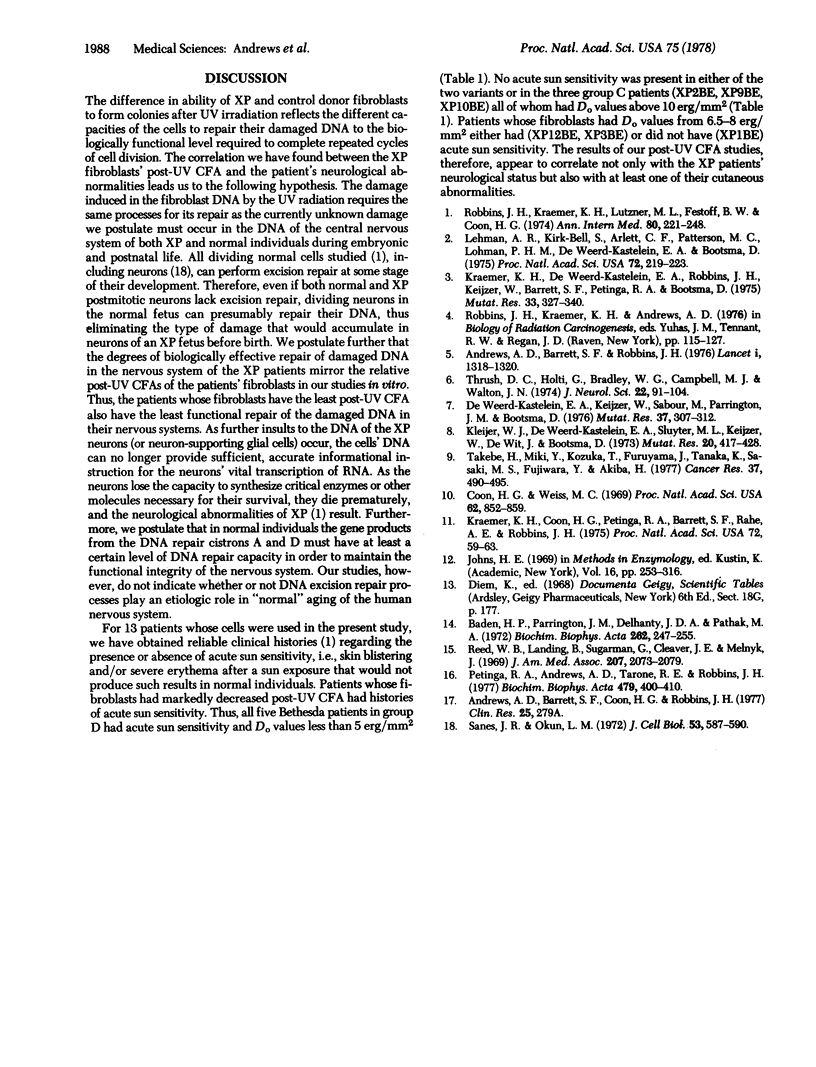
Images in this article
Selected References
These references are in PubMed. This may not be the complete list of references from this article.
- Andrews A. D., Barrett S. F., Robbins J. H. Relation of D.N.A. repair processes to pathological ageing of the nervous system in xeroderma pigmentosum. Lancet. 1976 Jun 19;1(7973):1318–1320. doi: 10.1016/s0140-6736(76)92652-0. [DOI] [PubMed] [Google Scholar]
- Baden H. P., Parrington J. M., Delhanty J. D., Pathak M. A. DNA synthesis in normal and xeroderma pigmentosum fibroblasts following treatment with 8-methoxypsoralen and long wave ultraviolet light. Biochim Biophys Acta. 1972 Mar 24;262(3):247–255. doi: 10.1016/0005-2787(72)90260-2. [DOI] [PubMed] [Google Scholar]
- Coon H. G., Weiss M. C. A quantitative comparison of formation of spontaneous and virus-produced viable hybrids. Proc Natl Acad Sci U S A. 1969 Mar;62(3):852–859. doi: 10.1073/pnas.62.3.852. [DOI] [PMC free article] [PubMed] [Google Scholar]
- Kleijer W. J., de Weerd-Kastelein E. A., Sluyter M. L., Keijzer W., de Wit J., Bootsma D. UV-induced DNA repair synthesis in cells of patients with different forms of xeroderma pigmentosum and of heterozygotes. Mutat Res. 1973 Dec;20(3):417–428. doi: 10.1016/0027-5107(73)90062-6. [DOI] [PubMed] [Google Scholar]
- Kraemer K. H., Coon H. G., Petinga R. A., Barrett S. F., Rahe A. E., Robbins J. H. National Cancer Institute, National Institutes of Health, Bethesda, Maryland 20014, USA. Proc Natl Acad Sci U S A. 1975 Jan;72(1):59–63. doi: 10.1073/pnas.72.1.59. [DOI] [PMC free article] [PubMed] [Google Scholar]
- Kraemer K. H., De Weerd-Kastelein E. A., Robbins J. H., Keijzer W., Barrett S. F., Petinga R. A., Bootsma D. Five complementation groups in xeroderma pigmentosum. Mutat Res. 1975 Dec;33(2-3):327–340. doi: 10.1016/0027-5107(75)90208-0. [DOI] [PubMed] [Google Scholar]
- Lehmann A. R., Kirk-Bell S., Arlett C. F., Paterson M. C., Lohman P. H., de Weerd-Kastelein E. A., Bootsma D. Xeroderma pigmentosum cells with normal levels of excision repair have a defect in DNA synthesis after UV-irradiation. Proc Natl Acad Sci U S A. 1975 Jan;72(1):219–223. doi: 10.1073/pnas.72.1.219. [DOI] [PMC free article] [PubMed] [Google Scholar]
- Petinga R. A., Andrews A. D., Tarone R. E., Robbins J. H. Typical xeroderma pigmentosum complementation group A fibroblasts have detectable ultraviolet light-induced unscheduled DNA synthesis. Biochim Biophys Acta. 1977 Dec 14;479(4):400–410. doi: 10.1016/0005-2787(77)90033-8. [DOI] [PubMed] [Google Scholar]
- Reed W. B., Landing B., Sugarman G., Cleaver J. E., Melnyk J. Xeroderma pigmentosum. Clinical and laboratory investigation of its basic defect. JAMA. 1969 Mar 17;207(11):2073–2079. doi: 10.1001/jama.207.11.2073. [DOI] [PubMed] [Google Scholar]
- Robbins J. H., Kraemer K. H., Lutzner M. A., Festoff B. W., Coon H. G. Xeroderma pigmentosum. An inherited diseases with sun sensitivity, multiple cutaneous neoplasms, and abnormal DNA repair. Ann Intern Med. 1974 Feb;80(2):221–248. doi: 10.7326/0003-4819-80-2-221. [DOI] [PubMed] [Google Scholar]
- Sanes J. R., Okun L. M. Induction of DNA synthesis in cultured neurons by ultraviolet light or methyl methane sulfonate. J Cell Biol. 1972 May;53(2):587–590. doi: 10.1083/jcb.53.2.587. [DOI] [PMC free article] [PubMed] [Google Scholar]
- Takebe H., Miki Y., Kozuka T., Furuyama J. I., Tanaka K. DNA repair characteristics and skin cancers of xeroderma pigmentosum patients in Japan. Cancer Res. 1977 Feb;37(2):490–495. [PubMed] [Google Scholar]
- Thrush D. C., Holti G., Bradley W. G., Campbell M. J., Walton J. N. Neurological manifestations of xeroderma pigmentosum in two siblings. J Neurol Sci. 1974 May;22(1):91–104. doi: 10.1016/0022-510x(74)90057-4. [DOI] [PubMed] [Google Scholar]
- Weerd-Kastelein E. A., Keijzer W., Sabour M., Parrington J. M., Bootsma D. A xeroderma pigmentosum patient having a high residual activity of unscheduled DNA synthesis after UV is assigned to complementation group A. Mutat Res. 1976 Nov;37(2-3):307–312. doi: 10.1016/0027-5107(76)90044-0. [DOI] [PubMed] [Google Scholar]



